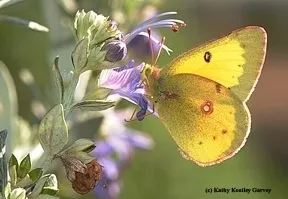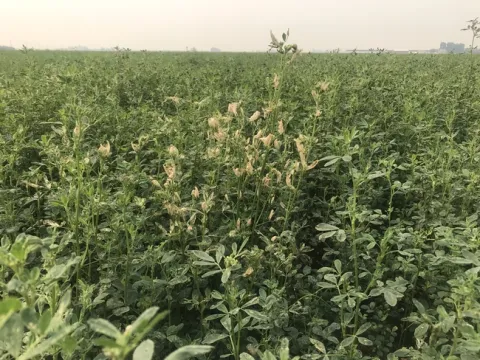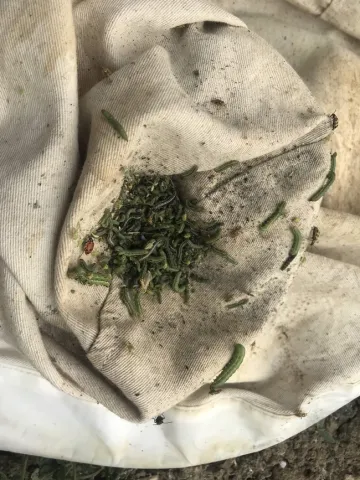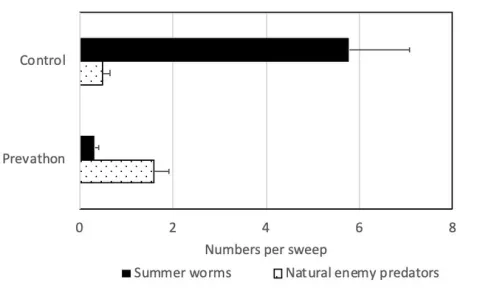Many splotches on your windshield? You are not alone.
Summertime brings various worm pests, including beet armyworm (Spodoptera exigua) and western yellowstriped armyworm (Spodoptera praefica), and alfalfa caterpillars (Colias eurytheme). Armyworms are larvae of moths while alfalfa caterpillars are larvae of the pretty white and yellow butterflies (aka. sulphur butterfly), that we see flying around alfalfa fields. Females tend to be white and males yellow.

Figure 1. Alfalfa Butterfly (AKA sulfur butterfly) adult feeding on flowers. (photo: Kathy Keatley Garvey)
VIDEO SHOWING ALFALFA CATERPILLARS IN THE FIELD AND SWEEP TECHNIQUE
This year, alfalfa butterflies (Figure 1) are swarming in booming numbers in the Sacramento valley. Dr. Art Shapiro, UC Davis distinguished professor and butterfly specialist notes "We are beginning to come off what may be the biggest invasion in this region in 20 or 30 years. Such invasions occurred almost every year in the 1970s and 80s, decreased in the '90s and became rare since 2000. We really do not know why."
They appear to be triggered when growers cut and bale alfalfa when adult populations are high, with outflow in all directions. There were significant but much less extensive outbreaks in 2016, 2018 and 2019. Before that, the outbreak of 2011 was the last one comparable to this.
"The current outbreak is regional in the Sacramento Valley, including urban areas. It seemingly peaked in the past two days and is now waning" Shapiro adds.
Significant Crop Losses from Larvae. While the adult butterflies feed on flowers and don't do damage (other than splattering on your vehicle's grill), the larvae of summer worm pests can be highly damaging to alfalfa. The larvae feed on the foliage, causing significant yield and quality losses (Figure 2). Alfalfa caterpillars eat entire leaves while armyworms tend to skeletonize leaves, leaving behind tattered foliage or ‘whitecaps' in the field (Figure 3).
Factors that contribute to summer worm infestations include lack of natural enemies, hyperparasites (other parasitoid wasps attacking the wasps that parasitize the caterpillars, thus reducing their numbers). Hot, dry weather that can also stress fields, causing slow or uneven growth of the crop, and more vulnerability to pests.
Sweep to Monitor Summer Worms. Monitoring for summer worms involves taking five sweep net samples in each of four different areas of an alfalfa field (Figure 4). Count the number of summer worms per sweep. Also check for percent parasitism by pulling apart small worms and looking for a tiny parasitoid wasp larva inside the worm. When an average of 10 or more armyworms and alfalfa caterpillars per sweep are found with no parasitoids, and the population is obviously increasing along with damage, it's time to control them.
See UC IPM Website for a complete review of these pests in alfalfa.
Control Strategies.When hay prices are up, fields are usually treated with insecticides for summer worm control, allowing the alfalfa to grow for maximum tonnage. When prices are lower, fields are often cut to control worms (they die after cutting). Harvest avoids costly pesticide sprays. For insecticide treatment, selected products have minimal effects to natural enemies that help to control other pests in the field, like aphids. These insecticides include Intrepid, Prevathon/Coragen (chlorantraniliprole), and the Bt's such as XenTari.
August 2020 Alfalfa Field Trial. In an alfalfa field in Yolo County Prevathon showed excellent control of summer worms, without damaging predator populations (Figure 5). Prevathon works by stopping worms from feeding after exposure, and the worms slowly die of starvation. By day 5, where Prevathon was used, the alfalfa field recovered from summer worm damage. The untreated controls had an average of 25-30% damage (foliage loss). At the time of treatment, there were thousands of native ladybugs in the field; it was gratifying to see that they were thriving under the Prevathon treatment, along with lacewings and syrphid flies. Natural enemies in alfalfa fields also serve as a source of beneficial insects for surrounding crops.
More information on armyworms and alfalfa caterpillars can be found on the UC IPM guidelines for alfalfa at http://ipm.ucanr.edu/PMG/r1900711.html

Figure 2. Alfalfa infested with beet and western yellowstriped armyworms.

Figure 3. ‘Whitecaps', tattered foliage from armyworm feeding damage in alfalfa.

Figure 4. Mixture of worms from a sweep net sample, Yolo Co., CA.

Figure 5. Summer worm infestation (beet and western yellowstriped armyworms and alfalfa caterpillar with Prevathon versus control (unsprayed) plots in alfalfa, Yolo Co., August, 2020. Prevathon had no negative impact on natural enemies (ladybugs, lacewings, and syrphid flies).

